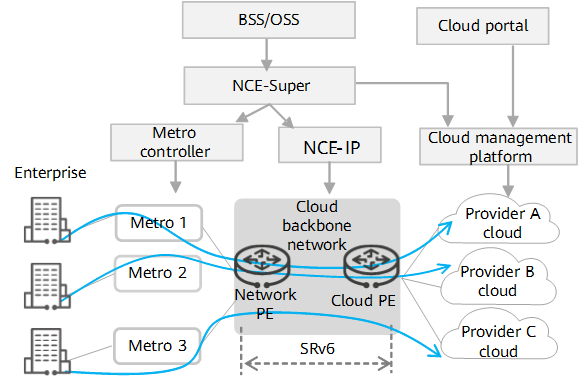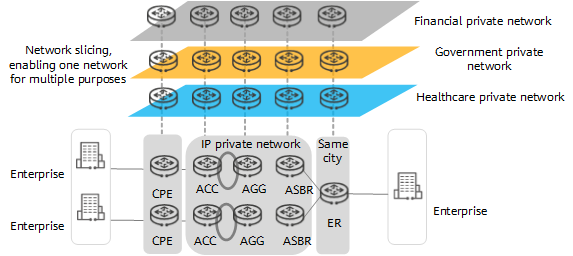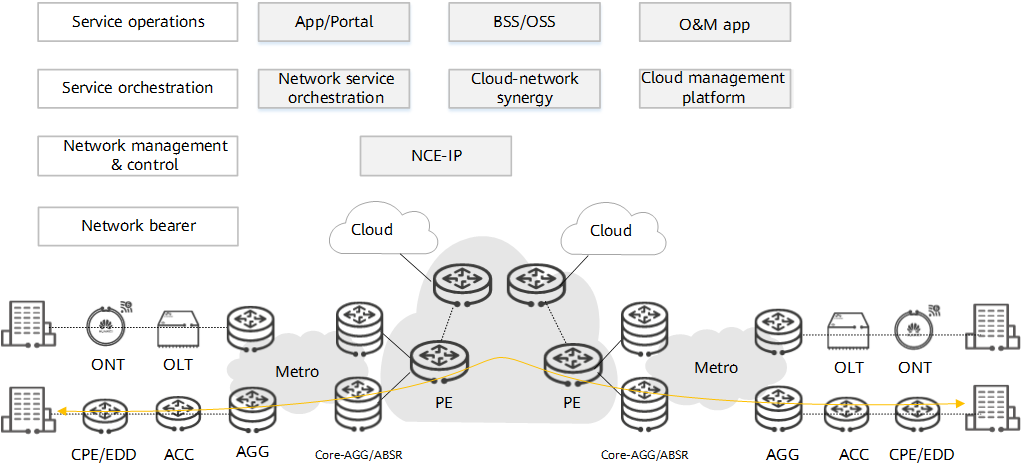What Is an IP Private Line?
IP private line is a private line technology that features shortest path interconnection, flexible granularity, and SLA visualization. As the digital transformation of enterprises continues to drive enterprise services to the cloud, enterprises are raising higher and higher requirements on IP private line services. Fundamental among those requirements are SLA assurance, fast provisioning, and on-demand bandwidth self-service. In terms of carrier-provided private line services, the changes that enterprise services are currently undergoing are posing even higher requirements. The IP private line solution has been developed to help carriers meet these requirements and build differentiated advantages. With Segment Routing IPv6 (SRv6) and Software-Defined Networking (SDN), this solution significantly lowers the technical requirements of private line services on intermediate networks, enabling carriers to fully utilize existing networks to quickly provision such services and consequently seize market opportunities. Furthermore, this solution uses Network Cloud Engine (NCE) to visualize network-wide resources and deliver SLA assurance for enterprise private line services on demand, helping carriers provide premium IP private line services.
Why Do We Need IP Private Line?
Private line services are high-quality, professional connection services provided by carriers over national backbone networks and broadband metro networks to enterprises, governments, and other customers who have high data access requirements. With the rapid development of digital transformation and cloud-based applications, the service flow directions and traffic composition of enterprises have changed significantly. To achieve higher operational efficiency, lower costs, and higher data security, enterprises are focusing their service development efforts on cloud migration and service cloudification, which require flexible networking, agile interconnection, and flexible bandwidth. As a result, the changes to enterprise services are posing higher requirements on carrier-provided private line services. At present, the private line service market shows the following trends.
Enterprise Cloudification Drives Continuous Growth of Private Line Services
The wave of enterprise digitalization has given rise to numerous opportunities. As the digital transformation of enterprises becomes more cloud-, video-, and 5G-based, differentiated service requirements are emerging. Carriers need to provide enterprises with "private line + cloud + X" services to build differentiated competitiveness over other carriers and Over-The-Top (OTT) providers.
High ROI Drives Independent Network Construction
In recent years, enterprise services have tended to concentrate in specific areas, opening up many potential opportunities for the private line market in service-intensive areas. Deploying private line networks in these areas for high-value customers will bring a high Return On Investment (ROI). As a result, the potential market return of the private line market drives the acceleration of private line network construction.
Private Line Services Are Shifting from MSTP to IP Due to Device Aging
Multiple Spanning Tree Protocol (MSTP) private line services currently account for a high proportion of all private line services. However, millions of MSTP devices in use today face issues such as aging, lack of standard evolution, and resource exhaustion. These issues mean that it is impossible to expand the capacity of many low-order private line services in the future. Compared with their IP counterparts, MSTP private line services have weaker bandwidth adjustment capabilities and lower bandwidth utilization during data transmission. In addition, MSTP private line services involve complex configuration and require integration with multiple access networks in cross-domain scenarios. Because IP private line services overcome these pain points, carriers are starting to migrate their private line services from MSTP to IP on a large scale.
The IP private line solution provides differentiated competitiveness for carriers through intelligence. It delivers a high-quality bearer network that features high bandwidth, low E2E delay, fast provisioning, and agile adjustment for enterprises. By offering agility flexibility, reliability, and high ROI, this solution is an ideal catalyst for enterprise digital transformation.
Core Benefits of IP Private Line
The IP private line solution uses SDN to provide an intelligent architecture, which forms distinctive competitiveness over other private line solutions. This solution consists of the service operation layer, service orchestration layer, network management and control layer, and network bearer layer from top to bottom. As the intelligent network brain for the IP private line solution, NCE implements centralized management, control, and analysis of the entire network in the southbound direction and provides open network APIs in the northbound direction. These APIs allow NCE to quickly integrate and work with upper-layer systems. The following figure shows the IP private line network architecture.
IP private line network architecture
The IP private line network architecture offers the following benefits:
- Flexible, reliable bearing
NCE is a core component of the IP private line solution, enabling elastic bearer architecture and high-availability bearer assurance for various private line services. By providing minute-level Bandwidth On Demand (BOD), NCE delivers highly elastic bandwidth to cope with the tidal effect of human traffic, meeting the requirement for on-demand bandwidth adjustment during peak hours. NCE analyzes and collects SLA information (such as network-wide delay information) about NEs and links, computes service paths, and delivers policies to devices. It ensures high-reliability bearer at the device, network, and service levels and delivers E2E high availability and 50 ms protection switching for all services.
- Agile service provisioning
The IP private line solution leverages the flexibility of IP networks to carry multiple services over one line, laying a bearer foundation for service agility. NCE provides open northbound APIs oriented to service intents for quick integration with upper-layer OSSs/orchestrators and third-party CSPs. It is also compatible with legacy and third-party networks in the southbound direction, facilitating E2E agile service provisioning. Carriers can provision services within minutes after an enterprise customer subscribes to, modifies, or changes a service on the self-service page, speeding up the provisioning time of private line services and enhancing user experience.
- Service SLA assurance and commitment
With iFIT/TWAMP/Y.1731-based measurement and telemetry-based data collection, NCE enables real-time detection and visualization of E2E service performance data at the tenant level. NCE centrally computes paths on the entire network, plans and ensures the SLAs of private line services, and supports refined management and proactive optimization of high-value private line services.
- Intelligent service O&M
NCE uses its intelligent analytics engine to implement minute-level fault locating and predictive maintenance based on big data and AI.
Typical Application Scenarios of IP Private Line
IP private line is mainly used in the following three scenarios: cloud backbone network, industry IP private network, and premium IP private line.
Cloud Backbone Network
To meet enterprises' cloudification requirements and address the pain points associated with multi-network and multi-cloud integration, the IP private line solution provides cloud-network convergence in the cloud backbone network scenario for carriers. By leveraging advantages such as wide-coverage network resources, rich IDC resources, and localized services, carriers can build an open cloud backbone private network and integrate it with multiple clouds to prevent data loss caused by public cloud faults. Such integration also enables carriers to confine OTT service traffic to clouds, freeing up bandwidth on the backbone network.
The cloud backbone network is a bridge for cloud-network convergence. It meets the requirements of cloud services for high bandwidth, low delay, high reliability, high security, and service agility, and uses SRv6-based path selection and optimization to provide SLA assurance. The following figure shows the cloud backbone network solution. In this solution, clouds and metro networks are connected through the cloud backbone network, which is managed and controlled through SDN. Clouds provide access to enterprise services, and controllers provide open northbound APIs.

Cloud backbone network solution
A cloud backbone network has the following characteristics:
- Provides one-stop ICT services for enterprises.
- Allows flexible adjustment of private line resources.
- Reuses existing IPv6 networks to reduce cost. Only the two end nodes need to be upgraded to SRv6 devices, and intermediate nodes can be reused for IPv6 forwarding.
- Meets the requirements of different enterprises. In addition to meeting the requirements for online self-service offering portfolio subscription of micro, small, and medium-sized enterprises, it also meets the requirements of large enterprises for hybrid clouds (public clouds + private clouds) and professional DR and migration services.
Industry IP Private Network
The industry IP private network solution is a network slicing-based service bearer solution. It implements resource reservation on the device side and slice lifecycle management on the controller side, preventing high-value services from being affected by other services. Devices use FlexE/channelized sub-interfaces to isolate resources, and the controller (NCE) implements automated slice management, such as slice creation and visualization. A slice is equivalent to a physical network in terms of resource guarantee and decoupled from services. VPN services can be deployed on the slice plane for service isolation. The following figure shows the industry IP private network solution. This solution uses one physical network to carry financial, government, and healthcare services while providing hard isolation among these services, ensuring high service bandwidth and security.

Industry IP private network solution
The industry IP private network solution can be applied in two basic scenarios: Point-to-Point (P2P) private line and Multipoint-to-Multipoint (MP2MP) private line. The following SLA assurance schemes are available for P2P private line services:
- Bandwidth scheduling based on QoS queues (such as AF queues): Private line services are mapped to fixed AF queues for forwarding assurance. NCE ensures that the total bandwidth of private line endpoints does not exceed the AF queue bandwidth to ensure P2P private line bandwidth.
- Private line slices based on FlexE and channelized sub-interface technologies: Slicing technologies such as FlexE are used to isolate more resources for private line services in cases where the eight port queues cannot meet the requirements of increasingly diversified network services or QoS scheduling needs to be further performed in a slice. Services in different slices do not affect each other, and NCE ensures that the total bandwidth of private line endpoints does not exceed the slice bandwidth.
- Hop-by-hop resource isolation: For scenarios where customers have strict requirements on private line resource isolation, P2P private line services with hop-by-hop bandwidth reservation are provided.
Like P2P private line services, MP2MP site-to-site private line services also rely on QoS queue scheduling for resource assurance and slicing technologies such as FlexE and channelized sub-interface for resource isolation. An isolated slice can be either exclusively used by one service or shared by multiple services. Unlike a P2P private line service, an MP2MP site-to-site private line service has unpredictable flow directions and traffic volume, making it difficult to determine an appropriate bandwidth for the corresponding slice.
Industry IP private network services meet the SLA isolation requirements of high-value customers, allow flexible network reuse, reduce construction and maintenance costs, drive carriers' revenues, and resolve the pain point of traditional solutions that require a network to be built for each domain.
Premium IP Private Line
The premium IP private line solution is mainly used in IP Radio Access Network (RAN) converged bearer scenarios. In terms of network coverage, the IP RAN overlaps with the MSTP network. As MSTP devices are being retired from service on a large scale, millions of private lines are being gradually migrated to the IP RAN. In IP RAN scenarios, extremely bursty mobile services may affect private line services. The premium IP private line solution resolves the preceding pain point by providing highly reliable service assurance for IP RAN service scenarios. The following figure shows the premium IP private line solution. This solution uses E2E SRv6 to provide delay/bandwidth-based service path customization capabilities and uses NCE for centralized configuration and O&M of the entire IP RAN/backbone network. In addition, this solution integrates iFIT-based second-level detection, enabling service path convergence within 50 ms upon faults as well as connectivity fault detection and reporting within seconds.

Premium IP private line solution
The premium IP private line solution has the following characteristics:
- Larger bandwidth, meeting the video upgrade requirements of industries
- SRv6-based fast service provisioning and improved O&M efficiency
- Service-level high-precision SLA detection, reporting of service statistics within seconds, and graphical display of these statistics
- Author: Lin Chen
- Updated on: 2021-11-18
- Views: 2483
- Average rating:








